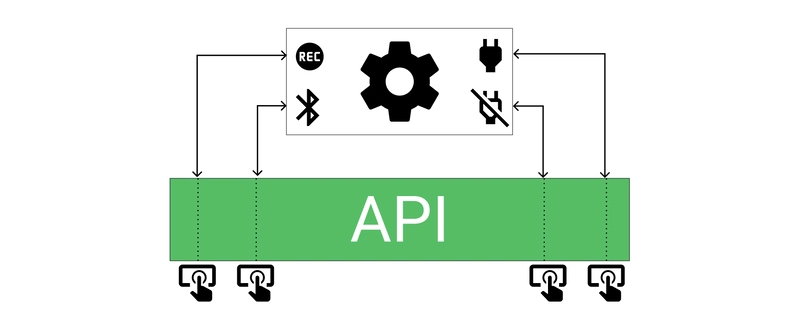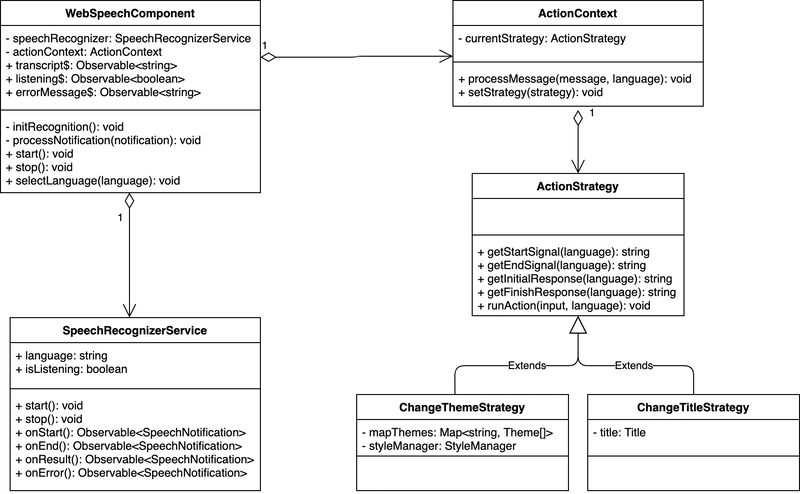构建您的第一个语音驱动的Web应用程序
前段时间,我有个目标:实现一个 Web 应用,能够自动记录我所说的内容,并允许通过语音命令执行操作。我觉得最好能提供一种方式来监听来自应用的反馈。快速研究之后,我发现了一些 Web API 可以解决这个问题。
在本文中,我将讲解如何使用现代 Web API 为您的 Web 应用添加强大的通信功能,并使其能够响应您的请求。我们将从零开始实现该应用。
什么是 API?
API 是应用程序编程接口 (Application Programming Interface)的缩写。根据MDN网站:
API 是编程语言中可用的构造,允许开发人员更轻松地创建复杂的功能。
简单来说,API 提供了一种创建复杂应用程序的方法,而无需学习或实现细节。
Web API
你曾经使用过fetch或Service Worker吗?也许你曾经在 JavaScript 中使用或访问过DOM ?
好吧,您可以基于这些功能完成复杂的任务,因为它们是大量Web API的一部分。这些 API 不是 JavaScript 的一部分,但是,您可以通过 JavaScript(或任何其他基于 JavaScript 的库/框架)使用它们。
另一方面,在开始构建基于 Web API 的应用程序之前,你可能需要确保你的 Web 浏览器完全支持该 API。例如,如果你打算使用fetch,你可以查看哪些浏览器或 JavaScript 引擎支持它。
Web 语音 API
正如您在上图中所看到的,此 Web API 可以帮助您完成以下操作:
- 生成语音转文本输出
- 使用语音识别作为输入
- 支持连续听写(可以写完整的字母)
- 网络浏览器的控制界面
更多详细信息请参阅Web Speech API规范。
语音合成接口
看完上面的图片你应该明白了。Web语音合成界面可以生成文本转语音的输出。
请参阅规范以了解有关此接口的更多信息。
观看视频
实现 Web 应用程序
该应用程序将基于 HTML、CSS 和 TypeScript 作为编程语言。我们将通过 Angular Material 组件使用最新版本的 Angular。
此外,我们将使用 Angular 中的Observables和AsyncPipe定义一种响应式编程方法。最后,我们将提供策略模式的实现以及其他一些功能。
创建项目
让我们使用最新的Angular CLI从头开始创建 Web 应用程序:
ng new web-speech-angular --routing --style css --prefix wsa --strict
--routing:为项目生成路由模块。--style:样式文件的文件扩展名。--prefix:为组件选择器设置前缀--strict:从Angular 10开始可用。启用更严格的类型检查并构建优化选项。
添加 Angular Material
此时添加 Angular Material 就很简单了:
ng add @angular/material
现在,我们可以按照Angular 的整体结构指南shared来生成material模块:
ng generate module shared --module app
ng generate module shared/material --module shared
这些命令将在您的项目中生成以下结构:
|- src/
|- app/
|- shared/
|- material/
|- material.module.ts
|- shared.module.ts
添加web-speech模块
现在是时候添加一个新模块来定义显示应用程序控件所需的组件了。
ng generate module web-speech --module app
ng generate component web-speech
现在我们将拥有以下结构:
|- src/
|- app/
|- shared/
|- web-speech/
|- web-speech.module.ts
|- web-speech.component.ts|html|css
添加web-apis目录
让我们创建一个新文件夹,将与我们将要使用的 Web API 相关的服务分组。此外,让我们为新服务支持的语言、通知、错误和事件定义一些 TypeScript 文件。
ng generate service shared/services/web-apis/speech-recognizer
运行上述命令并创建模型文件后,结构如下:
|- src/
|- app/
|- shared/
|- shared.module.ts
|- services/
|- web-apis/
|- speech-recognizer.service.ts
|- model/
|- languages.ts
|- speech-error.ts
|- speech-event.ts
|- speech-notification.ts
|- web-speech/
|- web-speech.module.ts
|- web-speech.component.ts|html|css
建模通知、事件和错误
由于当前规范是用 JavaScript 编写的,我们可以提供一些 TypeScript 代码来利用TypeScriptstrict功能。由于项目已配置为启用 TypeScript 模式,这一点尤为重要。
// languages.ts
export const languages = ['en-US', 'es-ES'];
export const defaultLanguage = languages[0];
// speech-error.ts
export enum SpeechError {
NoSpeech = 'no-speech',
AudioCapture = 'audio-capture',
NotAllowed = 'not-allowed',
Unknown = 'unknown'
}
// speech-event.ts
export enum SpeechEvent {
Start,
End,
FinalContent,
InterimContent
}
// speech-notification.ts
export interface SpeechNotification<T> {
event?: SpeechEvent;
error?: SpeechError;
content?: T;
}
注意SpeechError枚举。字符串键与SpeechRecognitionErrorEvent规范中的实际值匹配。
创建SpeechRecognizerService(异步语音识别)
主要目标是定义应用程序所需功能的抽象:
SpeechRecognizerService为(webkitSpeechRecognitionGoogle Chrome 支持的实例)定义基本配置。- 定义语言配置。
- 掌握中期和最终结果。
- 允许启动和停止识别器服务。
以下代码提供了这些要求的实现:
// speech-recognizer.service.ts
@Injectable({
providedIn: 'root',
})
export class SpeechRecognizerService {
recognition: SpeechRecognition;
language: string;
isListening = false;
constructor() {}
initialize(language: string): void {
this.recognition = new webkitSpeechRecognition();
this.recognition.continuous = true;
this.recognition.interimResults = true;
this.setLanguage(language);
}
setLanguage(language: string): void {
this.language = language;
this.recognition.lang = language;
}
start(): void {
this.recognition.start();
this.isListening = true;
}
stop(): void {
this.recognition.stop();
}
}
现在是时候提供一个面向响应式编程的 API,以便使用可观察对象实现持续数据流。这将有助于在用户持续说话时“捕捉”推断出的文本(我们不需要每次都拉取值来查看是否有新内容)。
export class SpeechRecognizerService {
// previous implementation here...
onStart(): Observable<SpeechNotification<never>> {
if (!this.recognition) {
this.initialize(this.language);
}
return new Observable(observer => {
this.recognition.onstart = () => observer.next({
event: SpeechEvent.Start
});
});
}
onEnd(): Observable<SpeechNotification<never>> {
return new Observable(observer => {
this.recognition.onend = () => {
observer.next({
event: SpeechEvent.End
});
this.isListening = false;
};
});
}
onResult(): Observable<SpeechNotification<string>> {
return new Observable(observer => {
this.recognition.onresult = (event: SpeechRecognitionEvent) => {
let interimContent = '';
let finalContent = '';
for (let i = event.resultIndex; i < event.results.length; ++i) {
if (event.results[i].isFinal) {
finalContent += event.results[i][0].transcript;
observer.next({
event: SpeechEvent.FinalContent,
content: finalContent
});
} else {
interimContent += event.results[i][0].transcript;
observer.next({
event: SpeechEvent.InterimContent,
content: interimContent
});
}
}
};
});
}
onError(): Observable<SpeechNotification<never>> {
return new Observable(observer => {
this.recognition.onerror = (event) => {
const eventError: string = (event as any).error;
let error: SpeechError;
switch (eventError) {
case 'no-speech':
error = SpeechError.NoSpeech;
break;
case 'audio-capture':
error = SpeechError.AudioCapture;
break;
case 'not-allowed':
error = SpeechError.NotAllowed;
break;
default:
error = SpeechError.Unknown;
break;
}
observer.next({
error
});
};
});
}
}
在前面的代码中,我们编写了返回Observable 的包装函数来管理以下事件处理程序:
recognition.onstart = function() { ... }
recognition.onend = function() { ... }
recognition.onresult = function(event) { ... }
recognition.onerror = function(event) { ... }
为了更好地理解这些功能的工作原理,请参阅SpeechRecognition Events、SpeechRecognitionResult和SpeechRecognitionErrorEvent的 API 规范。
致力于WebSpeechComponent
由于我们SpeechRecognizerService已经有了,现在是时候定义 Angular 组件了:
// web-speech-component.ts
import { ChangeDetectionStrategy, Component, OnInit } from '@angular/core';
import { merge, Observable, Subject } from 'rxjs';
import { map, tap } from 'rxjs/operators';
import { defaultLanguage, languages } from '../shared/model/languages';
import { SpeechError } from '../shared/model/speech-error';
import { SpeechEvent } from '../shared/model/speech-event';
import { SpeechRecognizerService } from '../shared/web-apis/speech-recognizer.service';
@Component({
selector: 'wsa-web-speech',
templateUrl: './web-speech.component.html',
styleUrls: ['./web-speech.component.css'],
changeDetection: ChangeDetectionStrategy.OnPush,
})
export class WebSpeechComponent implements OnInit {
languages: string[] = languages;
currentLanguage: string = defaultLanguage; // Set the default language
totalTranscript: string; // The variable to accumulate all the recognized texts
transcript$: Observable<string>; // Shows the transcript in "real-time"
listening$: Observable<boolean>; // Changes to 'true'/'false' when the recognizer starts/stops
errorMessage$: Observable<string>; // An error from the Speech Recognizer
defaultError$ = new Subject<undefined>(); // Clean-up of the previous errors
constructor(private speechRecognizer: SpeechRecognizerService) {}
ngOnInit(): void {
// Initialize the speech recognizer with the default language
this.speechRecognizer.initialize(this.currentLanguage);
// Prepare observables to "catch" events, results and errors.
this.initRecognition();
}
start(): void {
if (this.speechRecognizer.isListening) {
this.stop();
return;
}
this.defaultError$.next(undefined);
this.speechRecognizer.start();
}
stop(): void {
this.speechRecognizer.stop();
}
selectLanguage(language: string): void {
if (this.speechRecognizer.isListening) {
this.stop();
}
this.currentLanguage = language;
this.speechRecognizer.setLanguage(this.currentLanguage);
}
}
本质上,前面的代码展示了如何定义要完成的主要属性和功能:
- 允许切换语音识别的语言。
- 了解SpeechRecognizer何时在“聆听”。
- 允许从组件上下文启动和停止SpeechRecognizer 。
现在的问题是:我们如何获取文字记录(用户正在以文本形式讲话的内容),以及如何知道语音服务何时正在监听?此外,我们如何知道麦克风或 API 本身是否存在错误?
答案是:使用来自 的Observables 。我们SpeechRecognizerService不使用subscribe ,而是从服务中获取并分配Observables ,稍后将通过模板中的Async Pipes使用它。
// web-speech.component.ts
export class WebSpeechComponent implements OnInit {
// Previous code here...
private initRecognition(): void {
// "transcript$" now will receive every text(interim result) from the Speech API.
// Also, for every "Final Result"(from the speech), the code will append that text to the existing Text Area component.
this.transcript$ = this.speechRecognizer.onResult().pipe(
tap((notification) => {
if (notification.event === SpeechEvent.FinalContent) {
this.totalTranscript = this.totalTranscript
? `${this.totalTranscript}\n${notification.content?.trim()}`
: notification.content;
}
}),
map((notification) => notification.content || '')
);
// "listening$" will receive 'true' when the Speech API starts and 'false' when it's finished.
this.listening$ = merge(
this.speechRecognizer.onStart(),
this.speechRecognizer.onEnd()
).pipe(
map((notification) => notification.event === SpeechEvent.Start)
);
// "errorMessage$" will receive any error from Speech API and it will map that value to a meaningful message for the user
this.errorMessage$ = merge(
this.speechRecognizer.onError(),
this.defaultError$
).pipe(
map((data) => {
if (data === undefined) {
return '';
}
let message;
switch (data.error) {
case SpeechError.NotAllowed:
message = `Cannot run the demo.
Your browser is not authorized to access your microphone.
Verify that your browser has access to your microphone and try again.`;
break;
case SpeechError.NoSpeech:
message = `No speech has been detected. Please try again.`;
break;
case SpeechError.AudioCapture:
message = `Microphone is not available. Plese verify the connection of your microphone and try again.`;
break;
default:
message = '';
break;
}
return message;
})
);
}
}
模板WebSpeechComponent
正如我们之前所说,组件的模板将由Async Pipes提供支持:
<section>
<mat-card *ngIf="errorMessage$| async as errorMessage" class="notification">{{errorMessage}}</mat-card>
</section>
<section>
<mat-form-field>
<mat-label>Select your language</mat-label>
<mat-select [(value)]="currentLanguage">
<mat-option *ngFor="let language of languages" [value]="language" (click)="selectLanguage(language)">
{{language}}
</mat-option>
</mat-select>
</mat-form-field>
</section>
<section>
<button mat-fab *ngIf="listening$ | async; else mic" (click)="stop()">
<mat-icon class="soundwave">mic</mat-icon>
</button>
<ng-template #mic>
<button mat-fab (click)="start()">
<mat-icon>mic</mat-icon>
</button>
</ng-template>
</section>
<section *ngIf="transcript$ | async">
<mat-card class="notification mat-elevation-z4">{{transcript$ | async}}</mat-card>
</section>
<section>
<mat-form-field class="speech-result-width">
<textarea matInput [value]="totalTranscript || ''" placeholder="Speech Input Result" rows="15" disabled="false"></textarea>
</mat-form-field>
</section>
此时,应用程序已准备好启用麦克风并聆听您的声音!
添加SpeechSynthesizerService(文本转语音)
让我们首先创建服务:
ng generate service shared/services/web-apis/speech-synthesizer
将以下代码添加到该文件中。
// speech-synthesizer.ts
import { Injectable } from '@angular/core';
@Injectable({
providedIn: 'root',
})
export class SpeechSynthesizerService {
speechSynthesizer!: SpeechSynthesisUtterance;
constructor() {
this.initSynthesis();
}
initSynthesis(): void {
this.speechSynthesizer = new SpeechSynthesisUtterance();
this.speechSynthesizer.volume = 1;
this.speechSynthesizer.rate = 1;
this.speechSynthesizer.pitch = 0.2;
}
speak(message: string, language: string): void {
this.speechSynthesizer.lang = language;
this.speechSynthesizer.text = message;
speechSynthesis.speak(this.speechSynthesizer);
}
}
现在,应用程序就可以与您对话了。当应用程序准备好执行语音操作时,我们可以调用此服务。此外,我们还可以确认操作何时完成,甚至询问参数。
下一个目标是定义一组语音命令来通过应用程序执行操作。
通过策略定义行动
让我们思考一下应用程序中语音命令要执行的主要操作:
- 该应用程序可以通过 Angular Material 提供的任何其他主题更改默认主题。
- 应用程序可以更改应用程序的标题属性。
- 同时,我们应该能够将每个最终结果附加到现有的文本区域组件上。
针对这种情况,设计解决方案的方法有很多种。在本例中,我们来思考如何定义一些策略来更改应用程序的主题和标题。
目前,策略是我们最喜欢的关键词。在了解了设计模式之后,我们显然可以使用策略模式来解决这个问题。
添加ActionContext服务和策略
让我们创建ActionContext、ActionStrategy和ChangeThemeStrategy类ChangeTitleStrategy:
ng generate class shared/services/action/action-context
ng generate class shared/services/action/action-strategy
ng generate class shared/services/action/change-theme-strategy
ng generate class shared/services/action/change-title-strategy
// action-context.ts
@Injectable({
providedIn: 'root',
})
export class ActionContext {
private currentStrategy?: ActionStrategy;
constructor(
private changeThemeStrategy: ChangeThemeStrategy,
private changeTitleStrategy: ChangeTitleStrategy,
private titleService: Title,
private speechSynthesizer: SpeechSynthesizerService
) {
this.changeTitleStrategy.titleService = titleService;
}
processMessage(message: string, language: string): void {
const msg = message.toLowerCase();
const hasChangedStrategy = this.hasChangedStrategy(msg, language);
let isFinishSignal = false;
if (!hasChangedStrategy) {
isFinishSignal = this.isFinishSignal(msg, language);
}
if (!hasChangedStrategy && !isFinishSignal) {
this.runAction(message, language);
}
}
runAction(input: string, language: string): void {
if (this.currentStrategy) {
this.currentStrategy.runAction(input, language);
}
}
setStrategy(strategy: ActionStrategy | undefined): void {
this.currentStrategy = strategy;
}
// Private methods omitted. Please refer to the repository to see all the related source code.
// action-strategy.ts
export abstract class ActionStrategy {
protected mapStartSignal: Map<string, string> = new Map<string, string>();
protected mapEndSignal: Map<string, string> = new Map<string, string>();
protected mapInitResponse: Map<string, string> = new Map<string, string>();
protected mapFinishResponse: Map<string, string> = new Map<string, string>();
protected mapActionDone: Map<string, string> = new Map<string, string>();
constructor() {
this.mapFinishResponse.set('en-US', 'Your action has been completed.');
this.mapFinishResponse.set('es-ES', 'La accion ha sido finalizada.');
}
getStartSignal(language: string): string {
return this.mapStartSignal.get(language) || '';
}
getEndSignal(language: string): string {
return this.mapEndSignal.get(language) || '';
}
getInitialResponse(language: string): string {
return this.mapInitResponse.get(language) || '';
}
getFinishResponse(language: string): string {
return this.mapFinishResponse.get(language) || '';
}
abstract runAction(input: string, language: string): void;
}
// change-theme-strategy.ts
@Injectable({
providedIn: 'root',
})
export class ChangeThemeStrategy extends ActionStrategy {
private mapThemes: Map<string, Theme[]> = new Map<string, Theme[]>();
private styleManager: StyleManager = new StyleManager();
constructor(private speechSynthesizer: SpeechSynthesizerService) {
super();
this.mapStartSignal.set('en-US', 'perform change theme');
this.mapStartSignal.set('es-ES', 'iniciar cambio de tema');
this.mapEndSignal.set('en-US', 'finish change theme');
this.mapEndSignal.set('es-ES', 'finalizar cambio de tema');
this.mapInitResponse.set('en-US', 'Please, tell me your theme name.');
this.mapInitResponse.set('es-ES', 'Por favor, mencione el nombre de tema.');
this.mapActionDone.set('en-US', 'Changing Theme of the Application to');
this.mapActionDone.set('es-ES', 'Cambiando el tema de la Aplicación a');
this.mapThemes.set('en-US', [
{
keyword: 'deep purple',
href: 'deeppurple-amber.css',
}
]);
this.mapThemes.set('es-ES', [
{
keyword: 'púrpura',
href: 'deeppurple-amber.css',
}
]);
}
runAction(input: string, language: string): void {
const themes = this.mapThemes.get(language) || [];
const theme = themes.find((th) => {
return input.toLocaleLowerCase() === th.keyword;
});
if (theme) {
this.styleManager.removeStyle('theme');
this.styleManager.setStyle('theme', `assets/theme/${theme.href}`);
this.speechSynthesizer.speak(
`${this.mapActionDone.get(language)}: ${theme.keyword}`,
language
);
}
}
}
// change-title-strategy.ts
@Injectable({
providedIn: 'root',
})
export class ChangeTitleStrategy extends ActionStrategy {
private title?: Title;
constructor(private speechSynthesizer: SpeechSynthesizerService) {
super();
this.mapStartSignal.set('en-US', 'perform change title');
this.mapStartSignal.set('es-ES', 'iniciar cambio de título');
this.mapEndSignal.set('en-US', 'finish change title');
this.mapEndSignal.set('es-ES', 'finalizar cambio de título');
this.mapInitResponse.set('en-US', 'Please, tell me the new title');
this.mapInitResponse.set('es-ES', 'Por favor, mencione el nuevo título');
this.mapActionDone.set('en-US', 'Changing title of the Application to');
this.mapActionDone.set('es-ES', 'Cambiando el título de la Aplicación a');
}
set titleService(title: Title) {
this.title = title;
}
runAction(input: string, language: string): void {
this.title?.setTitle(input);
this.speechSynthesizer.speak(
`${this.mapActionDone.get(language)}: ${input}`,
language
);
}
}
注意此服务的用途SpeechSynthesizerService和调用位置。当您使用该speak功能时,应用程序将使用您的扬声器回答您的问题。
源代码和现场演示
源代码
完整项目请见 GitHub 仓库:https://github.com/luixaviles/web-speech-angular。如果您希望贡献更多功能,请记得点赞⭐️或发送 Pull 请求。
现场演示
打开 Chrome 网络浏览器并访问https://luixaviles.com/web-speech-angular/。查看应用内的注释,并使用英语甚至西班牙语进行测试。
最后的话
尽管该演示是使用 Angular 和 TypeScript 编写的,但您可以将这些概念和 Web API 与任何其他 JavaScript 框架或库一起应用。
您可以在Twitter和GitHub上关注我,以了解有关我的工作的更多信息。
感谢您的阅读!
——路易斯·阿维莱斯
 后端开发教程 - Java、Spring Boot 实战 - msg200.com
后端开发教程 - Java、Spring Boot 实战 - msg200.com



